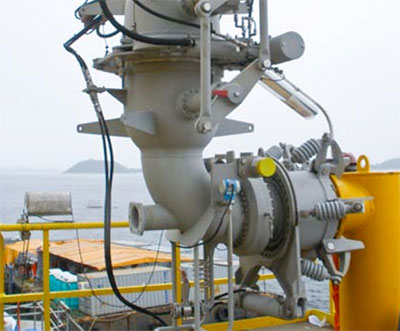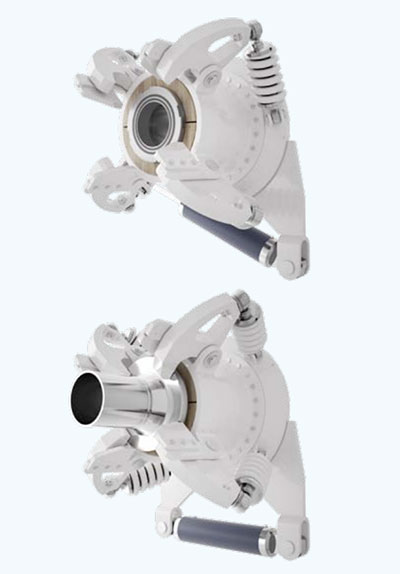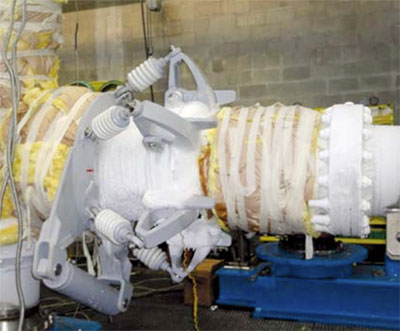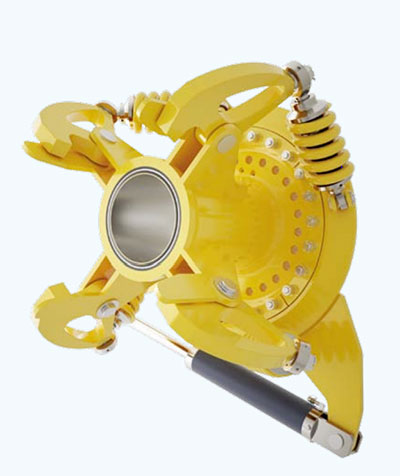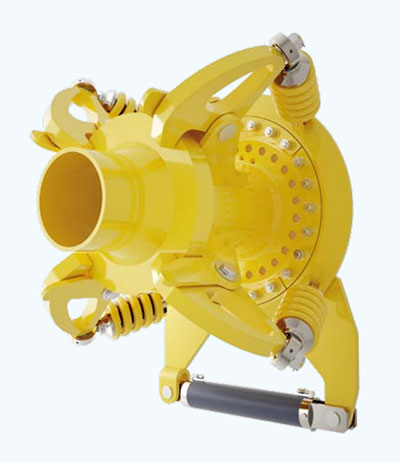ACOPLADORES COM DESENGATE DE EMERGÊNCIA MARÍTIMOS
The MIB Quick Connect/Disconnect Coupler is the quick and easy method to connect and disconnect a rigid marine arm or jetty hose to and from the vessel manifold.
Available for ambient, low temperature, cryogenic and CNG service conditions,QCDC coupling is hydraulically operated and can be adaptable to various sizes of manifold flange. Already installed in hundreds of terminals world wide together or without the MIB ERS system.
General
In 1971 it was MIB who developed, built and put into service the first cryogenic Quick Connect/Disconnect Coupler seen in the industry at Shell’s LNG Export terminal at Lummet, in Brunei.
The QCDC consists of a main fluid carrying body which (at rear) has a flange for connection to the loading arm or hose. At the front QCDC has a flange which houses the seals that ensure leak-tight connections to the tanker manifold flange.
The QCDC clamps are radially mounted around the fluid carrying body and connected via high stiffness spring rods to a rotating collar which is mounted on the body
Key Features
• Overcentre fully compliant with OCIMF recommendations mechanical lock to prevent undue release.
• Clamps operated simultaneously by a single double acting hydraulic cylinder
• Evenly distributed forces applied to the ship’s manifold flange.
• Moving parts insulated from the product to avoid icing (for Cryogenic
application).
• External centring guides to align with ships manifold flange.
• Guarranted clamping even in the event of hydraulic or electric power failure.
Design
Available for ambient, liquefied low temperature or cryogenic gases, CNG service in diameters from 2" to 24"
High or low pressure designs are available as bespoke solutions for specific installations.
Sizes: 2" to 24"
Pressure rating: ASME B16.5 Cl 150, 300, 400, 900 and Customised
Temperatures: -196 °C up to +250 °C
Fluids: LNG, CNG, LPG, Ethylene, Crude Oil and Petrochemicals
The coupler hooks are radially mounted around the body and connected via high stiffness spring struts to a rotating collar.
The collar is rotated by means of a single hydraulic cylinder on a bronze bearing.
In the fully open position the spring rods form an acute angle with the collar. During the closure phase rotation of the collar cause the angle of the rods to reduce, the spring to compress progressively and the clamps to close. In the final locking phase the rods move slightly overcentre respect to the clamps; further rotation of the collar is prevented by preset mechanism limits. Compression of the spring struts induces clamping forces in the hooks sufficient to resist the internal pressure and externally applied forces under all design and test conditions.
In the event of failure of the hydraulic supply to the QCDC the unit can be disconnected from the tanker manifold by means of a hydraulic hand pump.
The speed of operation of the coupler is dependent on the flow rate of hydraulic oil reaching the cylinder from the main power pack supplied for operation of the loading arms. Most operators have the coupler set to connect/disconnect in approximately seven or eight seconds, however this can be increased or decreased as required by a particular client.
The coupler is fitted with external centring guides, which align, on the outside diameter of the tanker flange to ensure correct positioning of the front flange of the coupler during the connecting operation.
When the coupler is not in service, it is fitted with a blanking plate, to prevent ingress of moisture, debris, etc, into the loading area.
For Cryogenic applications, in order to prevent ice build-up on the rotating components of the coupler, a second body is mounted on the fluid-carrying body by means of the insulating rings that are made from special insulating. The coupler is designed to ensure that the interface connection is leak-free during cool-down of the loading arm and during full cargo transfer.
